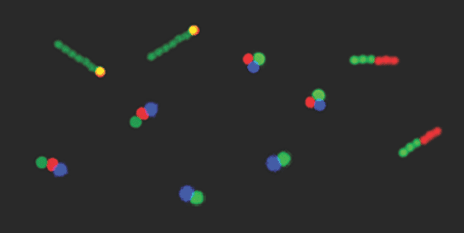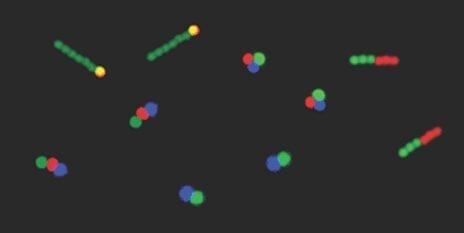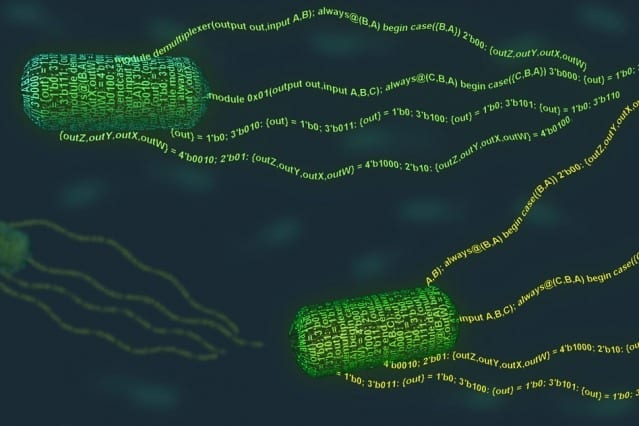
A new method allows scientists at ETH Zurich and IBM to fabricate artificial molecules out of different types of microspheres. The researchers would like to one day use such tiny objects in micro-robots, for photonics and basic biochemical research.
Scientists at ETH Zurich and IBM Research Zurich have developed a new technique that enables for the first time the manufacture of complexly structured tiny objects joining together microspheres. The objects have a size of just a few micrometres and are produced in a modular fashion, making it possible to program their design in such a way that each component exhibits different physical properties. After fabrication, it is also very simple to bring the micro-objects into solution.
This makes the new technique substantially different from micro 3D printing technology. With most of today’s micro 3D printing technologies, objects can only be manufactured if they consist of a single material, have a uniform structure and are attached to a surface during production.
To prepare the micro-objects, the ETH and IBM researchers use tiny spheres made from a polymer or silica as their building blocks, each with a diameter of approximately one micrometre and different physical properties. The scientists are able to control the particles and arrange them in the geometry and sequence they like.
The structures that are formed occupy an interesting niche in the size scale: they are much larger than your typical chemical or biochemical molecules, but much smaller than typical objects in the macroscopic world. “Depending on the perspective, it’s possible to speak of giant molecules or micro-objects,” says Lucio Isa, Professor for Interfaces, Soft matter and Assembly at ETH Zurich. He headed the research project together with Heiko Wolf, a scientist at IBM Research. “So far, no scientist has succeeded in fully controlling the sequence of individual components when producing artificial molecules on the micro scale,” says Isa.
Diverse range of applications
With the new method, it is possible to manufacture micro-objects with precisely defined magnetic, non-magnetic and differently charged areas. Currently, the scientists can create small rods of varying lengths and composition, tiny triangles and basic three-dimensional objects. But the researchers are keen to develop the technique further. As possible future applications, they are considering self-propelled micro-carriers that move in an external electric field thanks to their sophisticated geometry and material composition.
Other possibilities include micro-mixers for lab-on-a-chip applications or, in the distant future, even micro-robots for biomedical applications which can grab, transport and release other specific micro-objects. Additionally, the researchers could design their artificial molecules so that they interact with each other and assemble together independently into larger ‘superstructures’. This would be for instance relevant for photonics (light-based signal processing). “Customised micro-structures are required in photonics. These could one day be manufactured with our components,” says Isa.
Production with micro-templates
To manufacture a large number of identical micro-objects at the same time, the scientists use polymer templates with indentations engraved in the form of the object they want to produce. The researchers developed a method that allows them to deposit one tiny sphere at a time during each step of the procedure. They can build up larger objects sequentially, choosing the type of sphere for each step. At the end, they connect the tiny spheres together by briefly heating them.
Learn more: Artificial molecules
The Latest on: Artificial molecules
[google_news title=”” keyword=”Artificial molecules” num_posts=”10″ blurb_length=”0″ show_thumb=”left”]
via Google News
The Latest on: Artificial molecules
- Revolutionary AI device utilizes few-molecule reservoir computing for blood glucose predictionon April 26, 2024 at 10:15 am
A collaborative research team from NIMS and Tokyo University of Science has successfully developed a cutting-edge artificial intelligence (AI) device that executes brain-like information processing ...
- High-precision blood glucose level prediction achieved by few-molecule reservoir computingon April 26, 2024 at 9:24 am
A collaborative research team from NIMS and Tokyo University of Science has successfully developed an artificial intelligence (AI) device that executes brain-like information processing through ...
- Revealing Protein-Ligand Interactions Using AI Enables Drug Discoveryon April 26, 2024 at 7:34 am
Researchers developed a method to assess the ability of small molecules to bind to hundreds of human proteins using AI and ML.
- Pfizer collab with Austrian research institute leads to new AI models for drug discoveryon April 26, 2024 at 3:29 am
A three-year collaboration between Pfizer and the Research Center for Molecular Medicine of the Austrian Academy of Sciences (CeMM), has resulted in a new AI-driven drug discovery method that could ...
- After AI protein folding, David Baker’s lab identifies millions of smaller drug candidateson April 25, 2024 at 1:36 pm
A new Science paper from the Baker lab details a novel method for quickly compiling a large library of macrocycle drug candidates.
- A shortcut for drug discovery: Novel method predicts on a large scale how small molecules interact with proteinson April 25, 2024 at 11:00 am
For most human proteins, there are no small molecules known to bind them chemically (so-called "ligands"). Ligands frequently represent important starting points for drug development but this ...
- The Difference Is the Data: Drug Discovery’s AI Revolutionon April 25, 2024 at 4:00 am
New data-intensive platforms continue to leverage artificial intelligence tools for improved speed and failure rate reductions for drug discovery.
- AI Hallucinations Are not Always bad – They Can Create New Antibioticson April 24, 2024 at 8:44 am
AI Hallucinations Are not Always bad - They Can Create New Antibiotics. hallucinations are also proving helpful for scientists to discover new drugs.
- AI designs new drugs based on protein structureson April 24, 2024 at 8:14 am
A new computer process makes it possible to generate active pharmaceutical ingredients quickly and easily based on a protein's three-dimensional surface. The new process could revolutionize drug ...
- How AI hallucinations could help create life-saving antibioticson April 24, 2024 at 5:42 am
Generative artificial intelligence (AI) models often hallucinate and invent information that isn't factual or can't be cited from source material. This behavior is usually a weakness, especially given ...
via Bing News










